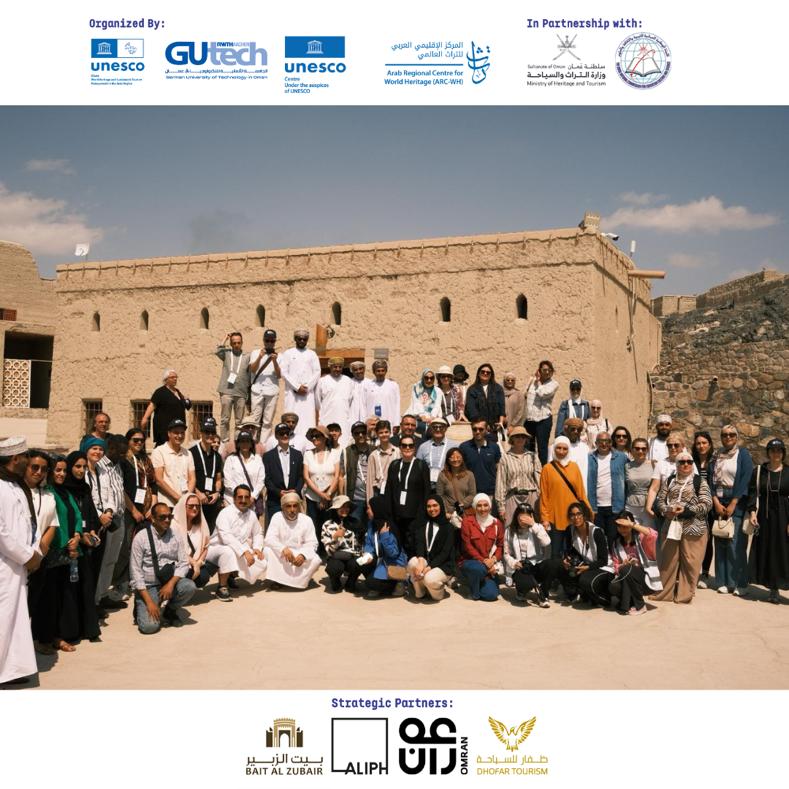During the third day of the international conference, “Opportunities for Heritage”, participants embarked on a full-day field trip to explore Oman’s rich cultural heritage sites, visiting various iconic locations.
Before stopping at the iconic sites of Bahla fort, the participants visited Jibreen Castle, a majestic structure that stands as a testament to the multifaceted roles that castles have played throughout history. Unlike forts, which were primarily built for defense, castles like Jibreen were centers of power, education, and administration.
The participants explored the castle’s impressive architecture and intricate design, which offers a window into the past, revealing the daily lives and intellectual pursuits of those who once roamed its halls.
Participants then explored the UNESCO World Heritage sites of Bahla Fort, a vast structure of mud brick atop stone foundations, along with the neighbouring Friday Mosque and its intricately carved prayer niche (mihrab), which stand out amidst the traditional mud-brick homes and lush palm groves that surround them.
Upon arrival, the melodies of Omani musicians playing traditional music welcomed the participants, setting the tone for an immersive cultural experience. Inside the fort, the presence of stands serving coffee and traditional Omani foods like Luqaimat enriched our visit, offering tastes of the region’s rich culinary heritage. Encircling both the fort and the lush oasis, the Bahla wall stands as a testament to the area’s historical significance and ingenuity.
Before reaching the fort, the field trip took the participants through the recently established “Oman Across Ages” museum, where we indulged in a lunch break and embarked on a tour revealing Oman’s geological history and ancient civilizations. The tour began with an exploration of Oman’s diverse geological features, from mountain folds to fractures, setting the stage for understanding the land’s ancient past. A fascinating overview of jewelry from 6000-4000 BC, crafted from various shells, highlighted the region’s long-standing tradition of adornment and craftsmanship. Our exploration concluded with insights into the Magan civilization, a Bronze Age society that thrived along the coast of North and Northeastern Oman, marking an intriguing chapter in Oman’s rich tapestry of history.
For their second visit during the field trip, participants explored Nizwa Fort, which was constructed during the rule of Imam Sultan bin Saif bin Malik Al Yarubi between 1649 and 1679 AD. The Nizwa Fort is a monumental structure from the early 11th century AH/mid-17th century AD. The construction of this formidable fortification spanned twelve years. Designed for defence, it includes cannon ports for protection. The fort’s entrance is accessed via a slender staircase shaped like the Arabic letter ح (equivalent to H in English), leading to seven strategically placed doors, each followed by a defensive turn. Above each door are openings designed for defence, adding to the fort’s impregnability.
The “Opportunities for Heritage” conference’s field trip on its third day proved to be an enlightening journey, enriching the participants’ understanding of Oman’s vast cultural landscape. From the architectural marvels of Jibreen Castle and Bahla Fort to the historical insights provided by the “Oman through the Ages” museum, each stop along the way offered a unique perspective on the Sultanate’s rich heritage. The exploration extended beyond these sites, encompassing the strategic Nizwa Fort and its adjacent vibrant souq showcased Oman’s ingenious ancient irrigation system.
This immersive experience, set against the backdrop of Oman’s stunning natural beauty and enhanced by the warmth of its people, highlighted the intricate tapestry of Oman’s history, culture, and contributions to civilization. The echoes of traditional Omani music, the taste of local delicacies, and the visual feast of ancient craftsmanship and architecture underscored the importance of preserving such heritage. As the conference aims to explore opportunities for heritage conservation and promotion, this field trip served as a reminder of the tangible and intangible values that heritage sites hold for humanity. It emphasized the need for continued efforts in heritage preservation, not only to honor past achievements but also to inspire future generations. Through the lens of Oman’s storied past, the “Opportunities for Heritage” conference participants were reminded of the universal value of cultural heritage and the shared responsibility to safeguard it for posterity.

